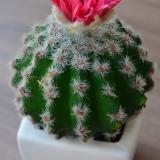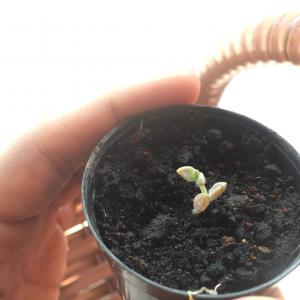文章
Miss Chen
2017年11月09日

Tomatoes require a deep root system to help pull water from the soil and keep full plants structurally sound. Helping the plant create a deep root system starts at planting. Deep root growth is increased in tomatoes when the seedlings are set deep in the soil, given plenty of water and given adequate space between plants. Tomatoes with deep root growth are more likely to also have an increase in fruit production over shallow-rooted plants.

Deep-Growth Benefits
Roots that grow deep below the plant help support the above-ground stem and branches. Deep roots are also able to maximize water absorption. Plants with shallow roots have an increased risk of drying out, developing fruit that forms poorly and developing stems that can't support heavy fruit production.
Planting Depth
Planting tomato seedlings deep into the garden soil increases the depth of root growth. The ideal depth for root growth on an mature plant is at least 18 inches, even though the main portion of the root system is found in the first 12 inches. To obtain this depth of root growth, dig a planting hole that allows you to set the seedling so the first set of true leaves are just above the soil line. Additional roots will form off the portion of stem that is below the soil level for a sturdy and deep-set plant.
Soil Factors
Loose garden soil assists in root growth by providing less resistance. Work the soil with a tiller or spade to a depth of 18 inches before planting the seedlings. Soil with a high clay content should be amended with compost to increase the organic content. High clay soils pack easily and are not ideal for deep root growth.

Care Considerations
Deep root growth requires some work on your part. Water tomato plants regularly to keep the soil evenly moist throughout the growing season. Healthy plants will not only grow tall, but also deep into the soil. Tomato plants that are in the fruit-producing stage require more water, up to 1 gallon per day. It is also ideal to set the plants 18 to 24 inches apart so they have adequate room for healthy and deep root growth.

Deep-Growth Benefits
Roots that grow deep below the plant help support the above-ground stem and branches. Deep roots are also able to maximize water absorption. Plants with shallow roots have an increased risk of drying out, developing fruit that forms poorly and developing stems that can't support heavy fruit production.
Planting Depth
Planting tomato seedlings deep into the garden soil increases the depth of root growth. The ideal depth for root growth on an mature plant is at least 18 inches, even though the main portion of the root system is found in the first 12 inches. To obtain this depth of root growth, dig a planting hole that allows you to set the seedling so the first set of true leaves are just above the soil line. Additional roots will form off the portion of stem that is below the soil level for a sturdy and deep-set plant.
Soil Factors
Loose garden soil assists in root growth by providing less resistance. Work the soil with a tiller or spade to a depth of 18 inches before planting the seedlings. Soil with a high clay content should be amended with compost to increase the organic content. High clay soils pack easily and are not ideal for deep root growth.

Care Considerations
Deep root growth requires some work on your part. Water tomato plants regularly to keep the soil evenly moist throughout the growing season. Healthy plants will not only grow tall, but also deep into the soil. Tomato plants that are in the fruit-producing stage require more water, up to 1 gallon per day. It is also ideal to set the plants 18 to 24 inches apart so they have adequate room for healthy and deep root growth.
0
0
文章
Miss Chen
2017年11月05日

Phoenix, the capital of Arizona, is situated in the Sonoran Desert. Growing blueberries in Phoenix can be tricky because of its hot, dry climate. However, several steps can help you to grow fully ripened fruits that carry a sweet taste and aroma not easily found in a grocery store. Even in a desert environment such as Phoenix, blueberry plants can grow to 3 feet to 4 feet tall and 20 inches wide or larger.

Step 1
Purchase a container in which to grow your blueberries, and pour in a potting soil mix that includes a blend of peat moss and compost so that the container is 3/4 full. Collect a sample of your soil and take it to a local laboratory in Phoenix to have it tested. The test will let you know what other amendments, if any, you must add to your soil.
Step 2
The ideal soil pH for blueberries generally is between 4.5 and 5.5. You will have to use a container in Phoenix because acidic soil is required for plants to grow and produce well. The soil in Phoenix is too alkaline, as it is composed mainly of clay and has large deposits of calcium carbonate.
Step 3
Buy a blueberry plant variety that has a low chill requirement, such as Southmoon, Sharpblue or Sunshine Blue, which will work well in Phoenix's desert climate. A low chill requirement is the amount of time a plant must be exposed to temperatures between 32 degrees Fahrenheit and 45 degrees Fahrenheit before it will come out of dormancy.

Step 4
Place your blueberry starter plant into the container, ensuring the container is large enough to handle the plant's existing root system. Situate the plant at the same level it was while in the initial pot, and firm the potting mix around the plant. Put the container in an area that receives exposure to full sun. The plant needs at least six hours of sun in order to thrive and will be able to handle full desert sun as long as it is well watered.
Step 5
Water your Phoenix blueberry plant whenever it feels dry, testing it daily with your finger. Apply a water-soluble fertilizer containing a commercial acidifying additive or vinegar to the plant each week from mid-February to Labor Day. This will compensate for the alkaline Arizona water you give your plant, which will cause the soil to lose its acidity over time.
Step 6
Pour 1/4 cup of coffee grounds over the soil every other week. This will further add acidity to the plant's soil, which will improve its production.
Step 7
Remove dead branches and twiggy growth from your blueberry plant. Make sure the plant remains in a round shape.

Step 1
Purchase a container in which to grow your blueberries, and pour in a potting soil mix that includes a blend of peat moss and compost so that the container is 3/4 full. Collect a sample of your soil and take it to a local laboratory in Phoenix to have it tested. The test will let you know what other amendments, if any, you must add to your soil.
Step 2
The ideal soil pH for blueberries generally is between 4.5 and 5.5. You will have to use a container in Phoenix because acidic soil is required for plants to grow and produce well. The soil in Phoenix is too alkaline, as it is composed mainly of clay and has large deposits of calcium carbonate.
Step 3
Buy a blueberry plant variety that has a low chill requirement, such as Southmoon, Sharpblue or Sunshine Blue, which will work well in Phoenix's desert climate. A low chill requirement is the amount of time a plant must be exposed to temperatures between 32 degrees Fahrenheit and 45 degrees Fahrenheit before it will come out of dormancy.

Step 4
Place your blueberry starter plant into the container, ensuring the container is large enough to handle the plant's existing root system. Situate the plant at the same level it was while in the initial pot, and firm the potting mix around the plant. Put the container in an area that receives exposure to full sun. The plant needs at least six hours of sun in order to thrive and will be able to handle full desert sun as long as it is well watered.
Step 5
Water your Phoenix blueberry plant whenever it feels dry, testing it daily with your finger. Apply a water-soluble fertilizer containing a commercial acidifying additive or vinegar to the plant each week from mid-February to Labor Day. This will compensate for the alkaline Arizona water you give your plant, which will cause the soil to lose its acidity over time.
Step 6
Pour 1/4 cup of coffee grounds over the soil every other week. This will further add acidity to the plant's soil, which will improve its production.
Step 7
Remove dead branches and twiggy growth from your blueberry plant. Make sure the plant remains in a round shape.
0
0
求助
kenzeeeeee
2017年11月05日

my plant here is dying and I do not know how to care for it. I feel if I know it's correct name, I'll be able to help it live.


0
0
Jabandit:Less water, more sunlight
AloeYouVeraMuch:Need more pictures, then I can give you an ID but I'd guess some sort of jade plant
小馒头331:Kalanchoe marnieriana?Is it?
hsfarmgirl
2017年11月05日

Cam anyone help me identify the correct succulent?! My grandma passed away a year ago and i got these from her place in June so havent seen them flower yet. Doing a college project on it and trying to figure out which succulent it is.


0
0
Jabandit:I’m pretty sure they don’t “flower” but I️ could be wrong
Ueca:Most likely Sempervivum tectorum, but it could just as likely be a cultivar like "Sunset" or "Red Rum".
文章
Miss Chen
2017年11月04日

Blueberries not only taste wonderful but are filled with nutrients such as vitamin C, manganese and antioxidants that can help ward off diseases. However, the high cost and low quality of blueberries in the store may keep you from enjoying this fruit. Luckily, blueberries aren't difficult to grow and one mature bush can yield several pounds of berries. Soil pH and proper fertilization are key components of growing your own blueberries.

Where to Plant
Blueberries will grow in most gardens with acidic soil. Although they can tolerate full sun, they do best in an area that is shaded during the hottest time of day. Avoid planting blueberries where they will be heavily shaded most of the day. Most blueberries do best planted in the ground, but some varieties have been cultivated to grow well in pots.
Soil Conditions
Blueberries planted in soil with a pH greater than 5.5 have difficulty taking up nutrients, and fruit production will suffer. The best pH for blueberries is 4.0 to 5.0. If your soil pH is higher than this optimal range, amend the soil with peat moss or pine needles to increase the acidity. Regardless of how much fertilizer you apply to your blueberries, if they aren't planted in acidic soil, the roots can't take in the nutrients efficiently.
When to Fertilize
Blueberries planted in a good location and in acidic soil don't require heavy feedings. Fertilize once in early spring when the shrubs come out of dormancy and start to produce leaves. Fertilize again when flower buds begin to appear in May or June. Do not fertilize blueberries after July.

Type of Fertlizer to Use
Good fertilizers for blueberries are high in nitrogen and potassium with a moderate amount of phosphorus and micronutrients. Fertilizers specifically intended for rhododendrons are ideal for blueberries since both plants require similar growing conditions. Blueberry plants with leaves that have turned yellow need iron in the form of iron sulfate or iron chelate. Yellow leaves signal that the soil is not acidic enough for the blueberry plant.

Where to Plant
Blueberries will grow in most gardens with acidic soil. Although they can tolerate full sun, they do best in an area that is shaded during the hottest time of day. Avoid planting blueberries where they will be heavily shaded most of the day. Most blueberries do best planted in the ground, but some varieties have been cultivated to grow well in pots.
Soil Conditions
Blueberries planted in soil with a pH greater than 5.5 have difficulty taking up nutrients, and fruit production will suffer. The best pH for blueberries is 4.0 to 5.0. If your soil pH is higher than this optimal range, amend the soil with peat moss or pine needles to increase the acidity. Regardless of how much fertilizer you apply to your blueberries, if they aren't planted in acidic soil, the roots can't take in the nutrients efficiently.
When to Fertilize
Blueberries planted in a good location and in acidic soil don't require heavy feedings. Fertilize once in early spring when the shrubs come out of dormancy and start to produce leaves. Fertilize again when flower buds begin to appear in May or June. Do not fertilize blueberries after July.

Type of Fertlizer to Use
Good fertilizers for blueberries are high in nitrogen and potassium with a moderate amount of phosphorus and micronutrients. Fertilizers specifically intended for rhododendrons are ideal for blueberries since both plants require similar growing conditions. Blueberry plants with leaves that have turned yellow need iron in the form of iron sulfate or iron chelate. Yellow leaves signal that the soil is not acidic enough for the blueberry plant.
0
0
求助
Nekala Keen
2017年11月01日

can anyone help me identify this plant please ?
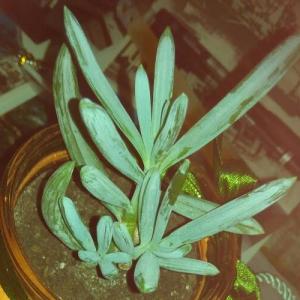

0
0
Nekala Keen:@Lora. ohh that might be it!! Thank you!
Lora.:It looks like Blue Chalk Sticks-Senecio mandraliscae
求助
Febrian Djaka Putra
2017年11月01日

Guys, need your help to identify this plant. Thanks. #Succulent #Kalanchoe #Echeveria
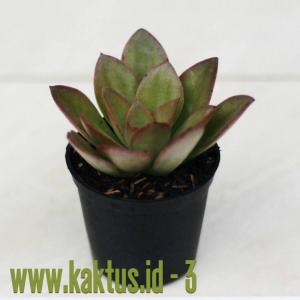

0
0
求助
Kiersten_27
2017年10月31日

I’ve been struggling to keep this mini ivy healthy, I just pruned the dead leaves off of it and it’s pretty scraggly. Any tips to help it get better and flourish?




1
0
Mohamad.hamidizade:Give less water and add perlite to the soil
Mohamad.hamidizade:After a while in the shade of spring, move it to the sun
Mohamad.hamidizade:This plant is poisonous, and it is better to transfer it outside and mix the soil with 30% sandstone,
Kiersten_27:@brielle Thank you!
brielle:@Kiersten_27 house plant addicts, house plant growers, house plant hobbyists, house plant hoarders.
显示更多
求助
JasmiNe Bale
2017年10月31日

Please help me ID succulents
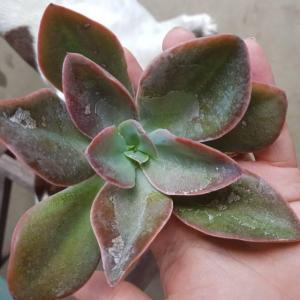

















1
0
Ueca:5. Echeveria pulvinata. 7. Echeveria glauca. 8. Graptopetalum paraguayense.
求助
Dorre
2017年10月29日

I have no idea wich plant this is. Can someone help me?
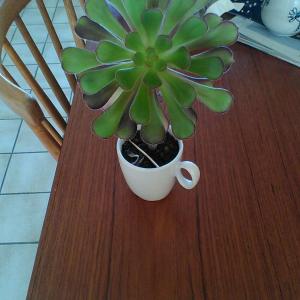

0
0
Brittany Paterson NJ:@Dorre it doesn’t necessarily need more- if you want it to be sun stressed (so it turns color) you’ll need more though! If it’s looking stretched out and leggy like it’s reaching toward the sky (most succulents are supposed to be small,tight, and compact.) then it really NEEDS more light!
Dorre:@Brittany Paterson NJ thanks 😊 I Just got him so it's Nice to know that it needs sunlight
Brittany Paterson NJ:It’s an Aeonium! More sun or artificial grow light will make the entire thing turn a beautiful deep purple/burgundy.
求助
Taurus_Girl
2017年10月28日

the tag said this is a Nomad Spring but I can't find and information about it or that it even exists. can anyone help me???


1
0
Ueca:I lost some sleep over this one. My conclusion is that it's a Gasteraloe, which is a hybrid between Gasteria and Aloe.
Perhaps it's an un-patented breed named "Nomad Spring".


